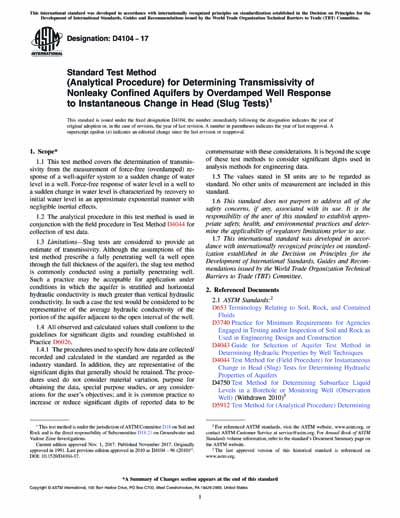Historical
ASTM D4104-17
Standard Test Method (Analytical Procedure) for Determining Transmissivity of Nonleaky Confined Aquifers by Overdamped Well Response to Instantaneous Change in Head (Slug Tests)
1.1 This test method covers the determination of transmissivity from the measurement of force-free (overdamped) response of a well-aquifer system to a sudden change of water level in a well. Force-free response of water level in a well to a sudden change in water level is characterized by recovery to initial water level in an approximate exponential manner with negligible inertial effects.
1.2 The analytical procedure in this test method is used in conjunction with the field procedure in Test Method D4044 for collection of test data.
1.3 Limitations—Slug tests are considered to provide an estimate of transmissivity. Although the assumptions of this test method prescribe a fully penetrating well (a well open through the full thickness of the aquifer), the slug test method is commonly conducted using a partially penetrating well. Such a practice may be acceptable for application under conditions in which the aquifer is stratified and horizontal hydraulic conductivity is much greater than vertical hydraulic conductivity. In such a case the test would be considered to be representative of the average hydraulic conductivity of the portion of the aquifer adjacent to the open interval of the well.
1.4 All observed and calculated values shall conform to the guidelines for significant digits and rounding established in Practice D6026.
1.4.1 The procedures used to specify how data are collected/recorded and calculated in the standard are regarded as the industry standard. In addition, they are representative of the significant digits that generally should be retained. The procedures used do not consider material variation, purpose for obtaining the data, special purpose studies, or any considerations for the user’s objectives; and it is common practice to increase or reduce significant digits of reported data to be commensurate with these considerations. It is beyond the scope of these test methods to consider significant digits used in analysis methods for engineering data.
1.5 The values stated in SI units are to be regarded as standard. No other units of measurement are included in this standard.
1.6 This standard does not purport to address all of the safety concerns, if any, associated with its use. It is the responsibility of the user of this standard to establish appropriate safety, health, and environmental practices and determine the applicability of regulatory limitations prior to use.
1.7 This international standard was developed in accordance with internationally recognized principles on standardization established in the Decision on Principles for the Development of International Standards, Guides and Recommendations issued by the World Trade Organization Technical Barriers to Trade (TBT) Committee.
Content Provider
ASTM International [astm]






